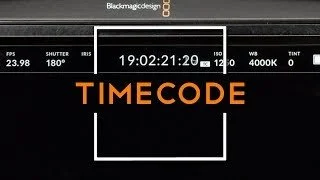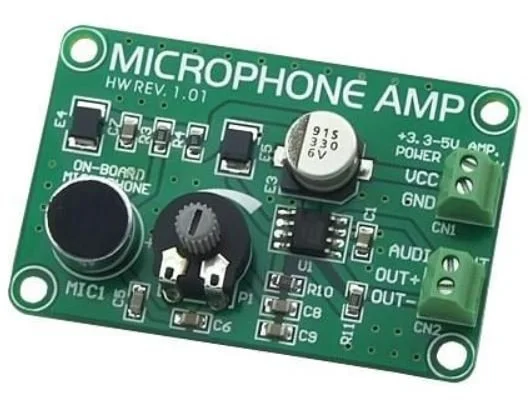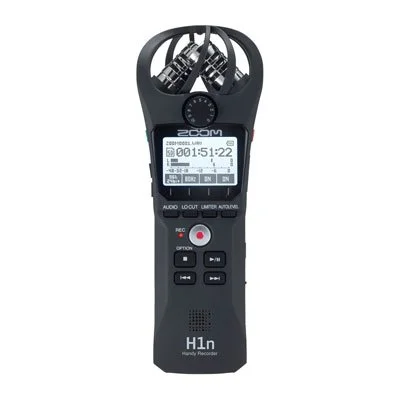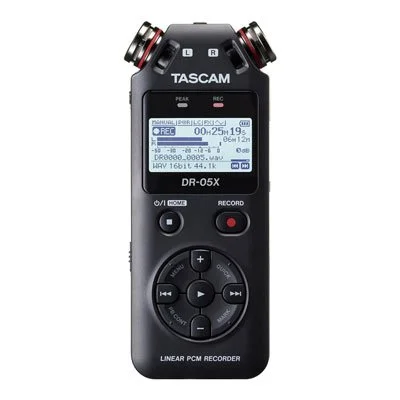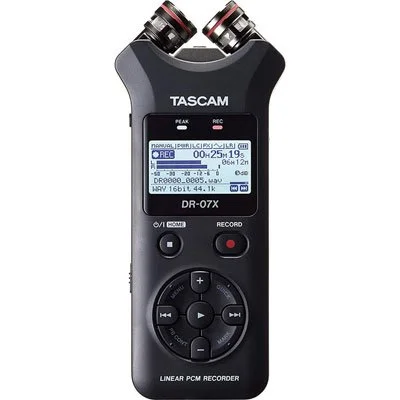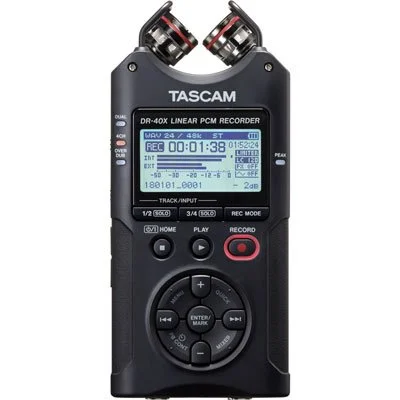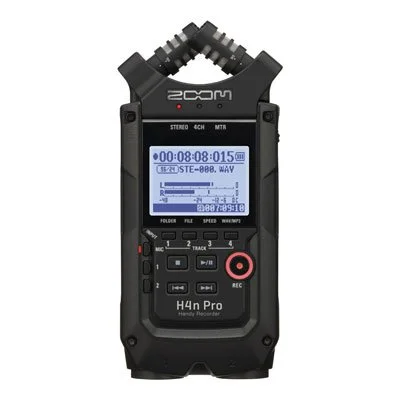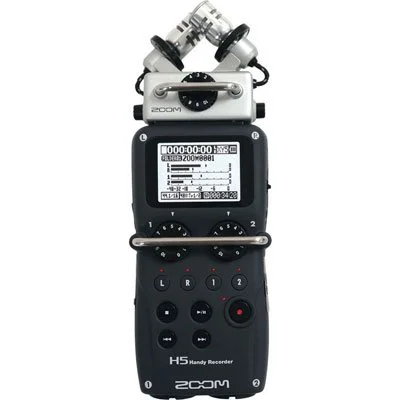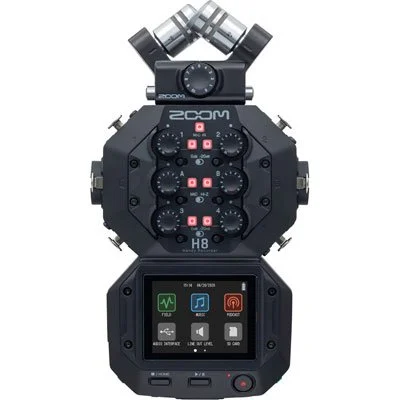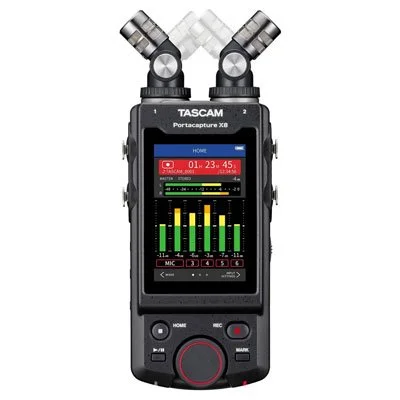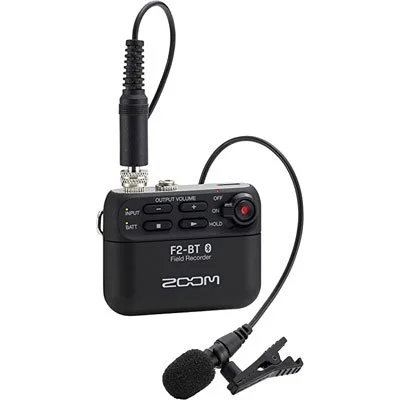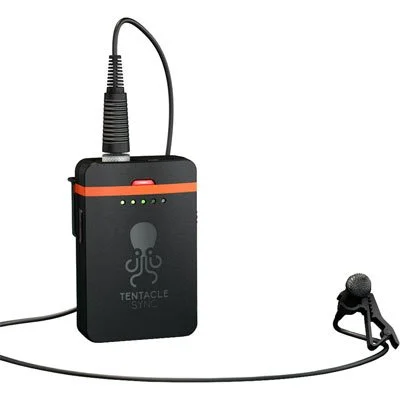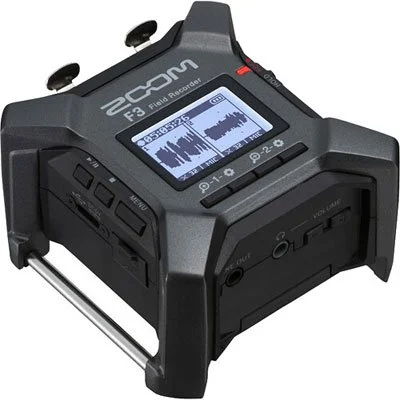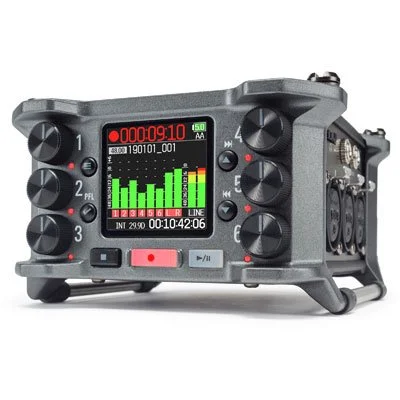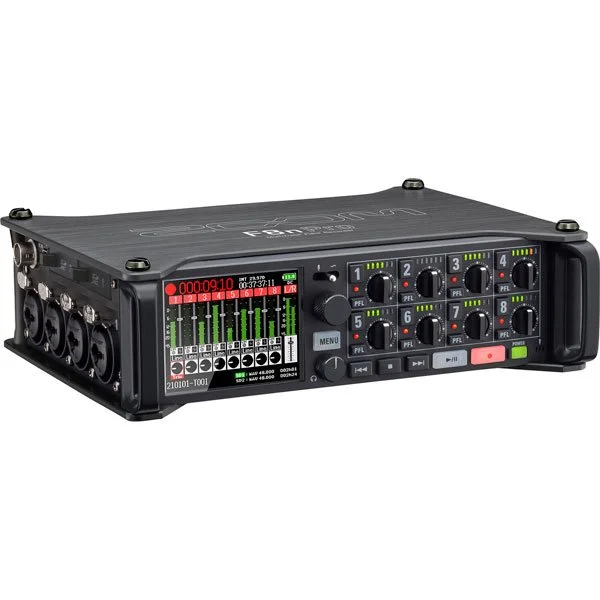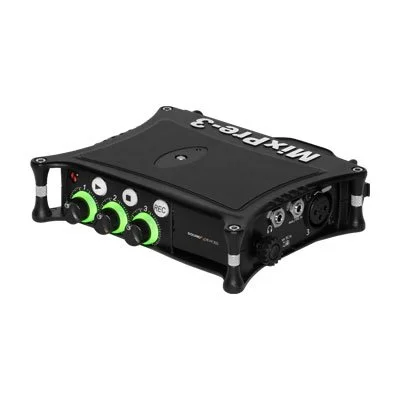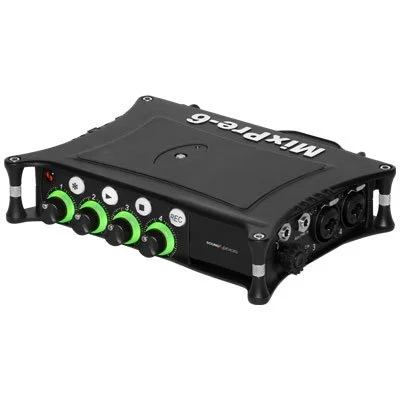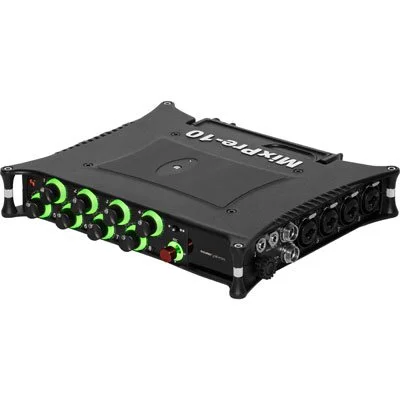Best Audio Recorder for Filmmaking
Professional advice on choosing the best field recorder for filmmaking in 2022.
Choosing the best field recorder for filmmaking can be a challenge, especially if you do not have a background in audio.
With all the technical jargon and specifications associated with field recorders, it can be difficult to tell which models are better than others.
In this educational article, you’ll learn about the most important field recording features; what they mean and why you should care.
If you’re a beginner, I suggest you read this post from top-to-bottom. In doing so, you’ll be able to make the best decision for your unique needs and budget.
In this post you’ll learn:
Important field recorder specifications and features
The differences between handheld and dedicated field recorders
The best field recorders available (for any budget)
My professional opinion for each option
Field Recorder Specifications To Know
In this section you’ll learn about the most important field recorder specifications for filmmaking.
Here’s an outline of the subjects covered:
Handheld vs Dedicated
A field recorder is at the heart of every field recordist’s kit. It is the device that will actually record the sounds you’d like to capture.
There are lots of different options available, but for this overview, we’ll split them into two categories:
Handheld field recorders
Dedicated field recorders
My collection of handheld field recorders.
Handheld field recorders are all-in-one recording devices that are small enough to fit comfortably in your hand. They have built-in microphones and are capable of recording sounds straight out of the box.
Because they need few accessories and are simple to operate, they are popular field recorders for beginners.
Although they generally don’t offer the sound quality or versatility of dedicated field recorders, there are ways around this and it is possible to get amazing recordings with handhelds.
Pro:
Small size
Require few accessories
Simple to operate
Con:
Limited features
Lower sound quality
Sound Devices 702T dedicated field recorder.
Dedicated field recorders are strictly for recording audio and require the additional purchase of external microphones in order to work.
They’re typically much larger than handheld recorders but offer many powerful features and settings that could make your workflow much easier.
Dedicated field recorders are made for professionals and are often used for recording sound for TV and filmmaking.
Pro:
Advanced settings
Awesome sound quality
Rugged construction
Con:
Bulky
Heavy
Require accessories
Timecode
Timecode is a system of measuring time by dividing time into frames.
It was developed in 1967 for film production by EECO, an electronics company that developed video recorders, to keep track of individual shots when there were multiple cameras filming at the same time.
The most common form of timecode displays hours, minutes, seconds and frames on a linear display in hh:mm:ss:ff format or as an alphanumeric string such as “00:00:01” (hour 00 minute 01 second).
For audio, timecode is used to synchronize multiple devices and media (both audio and video) on a metadata level.
Although many members of the production process use and make reference to timecode, it's particularly useful for editors and those who work in post-production.
During post-production, timecode is a major time-saver.
Because both audio and video will have timecoded frames in their metadata, you do not have to manually sync audio and video.
Instead, your DAW will automatically sync audio and video perfectly.
The best field recorders for filmmaking have timecode support.
Field recorders with timecode:
Self Noise
All field recorders and their microphone preamps have some level of self noise. Some have more than others and the total amount is especially important when recording quiet sounds below 40 dB.
Under these circumstances, self noise is arguably the most important factor to consider when choosing a field recorder because it directly impacts the overall sound quality.
Diagram of common sounds and their associated decibel levels. Use this diagram to determine how loud the sounds you want to record are.
Too much self noise can ruin a recording with overbearing static hiss.
My first field recording was of a quiet woodland captured with the internal microphones of a Tascam DR-40.
When I got home and listened to the sounds, the hissing self noise of the DR-40 overpowered the woodland ambience and was extremely distracting.
Know what self noise level is acceptable for your purposes so this doesn’t happen to you.
For researching field recorder self noise levels, I recommend this fantastic resource from Avisoft Bioacoustics. They have independently tested and measured the self noise values for most commercially available field recorders.
For the tests, they use equivalent input noise (EIN) to measure the amount of self noise.
Self noise ratings for the most commonly used measurement methods are listed below:
| Self Noise (dBA) | EIN (dBu) | SNR (dB) | Rating | Description |
|---|---|---|---|---|
| ≤ 12 |
-130 | ≥ 82 |
Ultra Quiet | Extremely low self noise. Undetectable even under the most critical recording conditions. |
| 16-13 | -126 | 78-81 | Very Good | Very slight noise discernable when recording the quietest signals. |
| 20-17 | -119 | 74-77 | Good | Good enough for most purposes. Noise noticeable in quieter recordings. |
| 24-21 | -110 | 70-73 | Fair | Noise obvious when recording anything below speaking level. |
| ≥ 24 |
-100 | ≤ 69 |
Poor | Not recommended unless you only record waterfalls, alarms and jets (very loud signals). |
For filmmakers, you’ll want a field recorder with a self noise rating of “Good” or better for recording dialog. If you plan to record location sound such as soundbeds, atmospheres, room tones, and sound effects, I recommend using a field recorder with a self noise rating of “Very Good” or better to eliminate any background hiss.
XLR Inputs
XLR inputs on a Zoom F3.
Some field recorders support external microphones that require 48V of power.
This power, called phantom power, is transferred from recorder to mic via an XLR cable.
With shotgun and other condenser microphones being extremely popular in filmmaking, it’s a good idea to purchase a field recorder with at least two XLR inputs.
Even if you don’t plan on using external microphones right away, investing in a field recorder capable of powering them will allow you to grow with the field recorder as you get more deeply involved with filmmaking.
Field Recorders with XLR inputs:
Zoom H4n Pro (x2)
Zoom H5 (x2)
Zoom H6 (x4)
Zoom H8 (x6)
Zoom F3 (x2)
Zoom F6 (x6)
Zoom F8n Pro (x8)
32-bit Float
Dynamic range comparison between 16-bit, 24-bit, and 32-bit float.
For the past decade, there has been little separating professional recording devices. 32-bit float changes that.
32-bit float is a groundbreaking innovation in audio recording. With over 1,500dB of dynamic range, clipping is impossible and setting gain levels doesn’t matter…you can always recover clipped audio in post production.
Having debuted in 2019, 32-bit floating point recording is a relatively new feature and there are few recorders on the market that offer it.
For filmmaking, 32-bit float will save you time and headaches.
With no need to set gain levels or worry about your levels clipping, 32-bit float is a luxury feature for filmmakers.
The only downside is you’ll have to manage and work with larger sized audio files since 32-bit float captures so much additional information in comparison to 24-bit.
Field recorders with 32-bit float:
Size and Weight
Field recorders come in many different sizes which often correspond to weight. If you have limited space, travel often, or weight requirements, size will be an important specification to consider when choosing a field recorder.
For example, as a nature field recordist, I need my field recorders to be small and lightweight. I often camp and record for multiple days in one location and with all my backpacking gear, my pack is already heavy and lacks space for recording gear.
Recording scenarios where size and weight are important:
Have far distance to carry equipment
Require many recording accessories
Require additional equipment outside of strictly recording
On the other hand, while having lighter, smaller, and less gear is always nice, some field recording settings allow you to lug in as much gear as you want.
Recording scenarios where size and weight are less important:
Have short distance to carry equipment
Have few additional accessories
Sole purpose is to record audio
Unless you are a “run and gun” style filmmaker, size and weight are generally not limitations.
Material
Field recorders are constructed from either plastic or metal. The most common metal used in field recorder construction is aluminum.
Both have their pros and cons so let's cover each material so you can decide which is best for you.
Plastic:
The Zoom H1n, a plastic field recorder.
Field recorders made of plastic have the following benefits:
Cheap
Less handling noise
Lightweight
Plastic is a very inexpensive material for manufacturers to use for constructing the body of field recorders. This savings is passed on to you (the consumer) and results in a more affordable device.
Another benefit of plastic is less handling noise. Plastic helps to deaden the vibrations created by the subtle movements of your hand while holding the recorder.
While practice and a balanced grip are still required for noiselessly holding a plastic
recorder, a plastic body makes this much
more feasible.
Lastly, plastic recorders are lighter than their aluminum siblings by about 50%.
Plastic field recorder cons:
Less durable
Prone to RF interference
Durability is the main downside of plastic field recorders. While some recorders are made of denser plastic than others, they all fall short to metal-bodied recorders when it comes to durability.
If you’re tough on gear, record in extreme environments, or travel frequently to record, plastic is not recommended.
A lesser drawback of plastic field recorders is their vulnerability to radio-frequency (RF) interference. Without additional RF protection, plastic-bodied field recorders will record RF interference as loud clicks, pops, and static.
These interference noises are only an issue if you’re recording in an environment with sources of RF interference. The closer your recorder is to these sources, the larger the risk of interference. Possible sources include:
Cell phones
WiFi
Bluetooth devices
Power lines and transformers
Power cables
Fluorescent light fixtures
2-way radios
If your recording environment contains these sources, consider going with an aluminum-bodied recorder or conducting research on a plastic-bodied recorder’s RF protection.
Aluminum:
The Sony D100, an aluminum field recorder.
Field recorders made of aluminum have the following benefits:
Great RF protection
Very durable
Aluminum naturally has a high resistance to RF interference. Aluminum-bodied field recorders block RF interference and make them a great choice for recording in urban areas.
Aluminum field recorders are also very durable. Although they may become scratched, they will handle drops, dings, and general wear much better than plastic field recorders.
Aluminum field recorder cons:
Expensive
Sensitive to handling noise
Heavier
Because aluminum costs more than plastic and is more difficult to work with, aluminum field recorders are more expensive than plastic ones. If you’re on a tight budget, you may not be able to afford an aluminum recorder.
Aluminum field recorders are also more sensitive to handling noise. Every slight movement of your hand, even the creaking of your joints, is transferred to the microphones and audible in the final recording. However, with practice, it is possible to noiselessly hold an aluminum recorder while recording; it’s just more difficult.
Lastly, aluminum field recorders are heavier than ones made of plastic. As previously mentioned, aluminum field recorders are about twice as heavy as the same sized device made of plastic.
Personally, I think the extra weight is well worth the durability benefits.
Because film sets are often in environments with lots of RF noise, I recommend going with an aluminum bodied field recorder.
Best Field Recorders for Filmmaking
Before getting into the field recorder options available in 2022, I’d like to point out that the results are split into 2 categories:
Handheld Field Recorders - All-in-one recording products with internal microphones.
Dedicated Field Recorders - Strictly for recording, require external microphones.
Handheld Field Recorders
Every single handheld field recorder on the market in 2022, sorted from lowest price to highest.
1. Zoom H1n
The Zoom H1n is the perfect field recorder for beginners.
Self noise is acceptable, the user interface is very simple and intuitive, good RF protection, extremely small, dedicated dial for adjusting gain, and it’s the cheapest field recorder on the market!
The only downsides are: cheap build quality (though better than the Tascam DR-05X), triple-A batteries offer shorter life than other options ( ≈ 10 hours), and fixed X-Y microphone configuration.
Professional Opinion: If you’re new to field recording and want to get started without spending a ton of money, the Zoom H1n is for you.
2. Tascam DR-05X
The Tascam DR-05X’s greatest feature is support for scheduled recordings. You can set specific times for the recorder to start and stop recording. However, the pros stop there.
The DR-05X is extremely prone to RF interference, made of cheap plastic, and has high self noise.
Professional Opinion: I would only purchase a DR-05X if scheduled recordings were absolutely necessary for my work and I was on a serious budget. Overall, the H1n is a much better device and cheaper.
3. Tascam DR-07X
For about $20 more than the DR-05X is the Tascam DR-07X. The best features on the DR-07X are the swiveling capsules allowing for either X-Y or wide stereo configurations.
However, with high self noise, the DR-07X is best suited for capturing loud signals such as dialog and busy environments. Not recommended for ambience work.
Professional Opinion: The Tascam DR-07X is good for beginners with a limited budget who want to experiment with different stereo widths without having to buy any extras. However, without any protection for the capsules while in wide stereo configuration, make sure nothing hits them. The cheap, plastic construction won’t hold up against rough use.
4. Tascam DR-40X
The Tascam DR-40X is the cheapest handheld field recorder with support for XLR inputs (x2).
However, with high self noise, the DR-40X is limited to recording loud signals and sounds at very short distances without background hiss.
Professional Opinion: The Tascam DR-40X is a great, low-budget option for recording loud signals such as dialog for podcasts/YouTube and music. For quieter environments, the DR-40X simply is not capable of capturing them without an overwhelming amount of hiss that will overpower your subject.
5. Zoom H4n Pro
The Zoom H4n Pro is the first real step-up in audio quality from the previous field recorders on this list.
With swiveling capsules for X-Y and 120° wide stereo, two XLR inputs, and far less noise than any of the previous options, the Zoom H4n Pro is a versatile and powerful field recorder appealing to musicians, songwriters, filmmakers, sound designers, and content creators.
With a noise floor of -120 dBu, it is quiet enough for some ambience work, but still benefits from denoise plugins.
Professional Opinion: The Zoom H4n Pro offers great value for its relatively low price. With features like unlimited overdubbing, amp simulation, and built-in effects (reverbs, delays, flangers, chorus, reverse effects), it’s particularly attractive to musicians with a little more to spend.
6. Zoom H5
The Zoom H5 is a somewhat strange extension of the “H” line of recorders.
Though costing more than the H4n Pro, the H5 does not include swiveling mics or built-in music effects (the only “effects” on the H5 are low-cut filter, compressor, limiter, and tuner).
However, the H5 did see some “quality of life” updates in the form of a more intuitive user interface, independent gain adjustment knobs for the XLR inputs, and interchangeable microphone capsules.
Virtually all other features remain the same between the two devices.
Professional Opinion: If you’re a musician and want to experiment with adding effects to your recordings without any computer processing, stick with the H4n Pro. The quality of life updates on the H5 are really only worth it for podcasting, content creators, and location sound recordists that will benefit from the independent gain adjustment knobs to compensate for different microphones or different speaker volume levels (you can still set independent gain levels on the H4n Pro, you just have to dive into the menus).
7. Zoom H6
The Zoom H6 adds two additional XLR inputs (for a total of 4), and a full-color LCD screen to the H-series line.
All other features and specifications are identical to the H5, including independent gain knobs for all four XLR input channels, and interchangeable microphone capsules.
Professional Opinion: The Zoom H6 is a good, low-budget option for users needing more XLR inputs. Ideal for podcasts with multiple guests, small music groups, and filmmaking work with multiple miked subjects.
8. Zoom H8
The Zoom H8 adds yet another two XLR inputs (for a total of 6), and a touch-screen, full-color interface to the H-series line.
The new “app-driven” touchscreen provides easy access to three optimized modes:
Podcasting - Four mic channels + two sound pad channels. 13 pre-loaded sounds to trigger sound effects and music beds. Can upload your own custom sounds.
Music - Record up to 10 input tracks, overdub, mix, and enhance recordings with EQ and compression.
Field Recording - Large meters for every track, quick access to input type, low-cut filters, compression, limiter, and noise gate settings.
Professional Opinion: Though I feel that touchscreens make devices less accessible, fragile, and limit life expectancy (useless when the touchscreen inevitably loses accuracy), the Zoom H8 is an affordable solution for users seeking more XLR inputs: large podcasts, full bands, larger location sound productions.
9. Tascam Portacapture X8
The Tascam Portacapture X8 is the only handheld field recorder capable of 32-bit float resolution.
With a large touch-screen, four XLR inputs, swiveling capsules, and “app-driven” controls, there’s a lot to like.
However, the implementation of these features is poor.
Units suffer from backlight bleeding, ultrasonic noise, fragile plastic capsules, laggy touch-screens, and confusing menu navigation.
Professional Opinion: I would not buy the Portacapture X8. Although it was a good idea, it was poorly executed, and seems rushed to market. If you want the benefits of 32-bit float, the Zoom F3 is actually cheaper than the Portacapture and is what I use. However, it’s a dedicated recorder with only two XLR inputs. If you need additional channels and 32-bit float, have a look at the Zoom F6.
Hopefully a new, handheld field recorder capable of 32-bit float will be released soon because the Tascam Portacapture X8 is not it.
Dedicated Field Recorders
Every single dedicated field recorder on the market in 2022, sorted from lowest price to highest.
1. Zoom F2 (Mono Only)
The Zoom F2 is a ultracompact, body-pack recorder capable of 32-bit float resolution.
It includes a lavalier microphone, foam windscreen, and microphone clip.
This no-frills option is simple, well-designed and runs on 2 AAA batteries. If it were made of aluminum it would be perfect. Instead, it is made out of cheap plastic.
Professional Opinion: 32-bit float is a very attractive feature for location sound recordists and solo content creators. Simply plug it in and start recording for worry-free audio that will never clip.
However, reviews of the Zoom F2 make it difficult to recommend. It seems that the F2 was rushed to market and not properly thought out. Many users complain that the lavalier microphone connection is not solid and recordings are unreliable. Additionally, the plastic battery cover is a major weak point in the design and will inevitably break with normal use.
I would purchase the Zoom F2 if my budget was extremely limited and I wanted the benefits of 32-bit float. If I had some extra money, the Tentacle Sync TRACK E is the more reliable option.
2. Tentacle Sync TRACK E (Mono Only)
The Tentacle Sync TRACK E is a professional body-pack recorder capable of 32-bit float.
It includes a lavalier microphone, foam windscreen, and microphone clip.
Additionally, the TRACK E supports timecode and multiple units can be jam-synced together for universal timecode for larger film sets.
Professional Opinion: The Tentacle Sync TRACK E is the best 32-bit float body-pack recorder on the market. Offering worry-free audio on set and timecode support for multiple units, it is the premier option for professional location sound recordists.
3. Zoom F3
The Zoom F3 is the smallest 32-bit float field recorder available (with support for stereo) and is built for professionals.
Featuring the same, ultra low noise preamps (-127dBu) as the rest of the F-series, the Zoom F3 has a very low noise floor, making it great for recording quiet ambiences like nature sounds and room tones.
The body is built from aluminum with robust side bars and has non-slip rubber feet on the bottom.
Professional Opinion: I own and use a Zoom F3 and absolutely love it. It’s small, lightweight, rugged, extremely quiet, and easily accepts external power via its internal USB-C port. I only wish it used full-sized SD cards and not micro. microSD cards are fragile and difficult to handle; very easy to drop and potentially lose/break when swapping in the field.
4. Zoom F6
The Zoom F6 is very similar in performance to the MixPre 6 II from Sound Devices but with several differences.
The F6 is smaller, more affordable, and supports L-series batteries and ambisonic recordings without having to purchase additional accessories or plugins.
One tradeoff between the F6 and the MixPre is preamp noise. The F6 preamps come in at -127dBu while the MixPre is quieter at -128dBu. However, this difference is virtually impossible to differentiate by ear.
Similar to the MixPre Series, the Zoom F6 also supports 32-bit float recordings and timecode.
Professional Opinion: The Zoom F6 is the most affordable 6 input dedicated field recorder on the market with few drawbacks. With its near best-in-class preamps, 32-bit float, and ultra portable size, the F6 is great for ambisonics and production audio on set.
4. Zoom F8n Pro
Released in 2022, the Zoom F8n Pro is the exactly the same as the F8n, but with support for 32-bit float recordings.
For a fraction of the price, the F8n Pro offers many of the same features as the Sound Devices MixPre 10 II including:
timecode
32-bit float
ultra low noise preamps
192kHz maximum sample rate
x2 TA3 outputs
x1 3.5mm output
full-color backlit LCD
The differences between the two, eight XLR input devices is in the F8n Pro’s favor.
Features on the F8n Pro not available on the MixPre 10 II:
dual memory card slots with simultaneous recording
native support for ambisonic recordings (the MixPre requires an additional plugin purchase)
AutoMix - This smart software automatically adjusts the levels of your mix to reduce the amount of ambient sound. Excellent for recording interviews, podcasts, or meetings while eliminating noise between gaps in conversation.
Professional opinion: Zoom really hit the ball out of the park with the F8n Pro. Designed for professional filmmakers with all the bells and whistles at a fraction of the price of the competition. With eight XLR inputs, ultra quiet preamps, and 32-bit float, the F8n Pro could be the last field recorder you ever buy.
5. Sound Devices MixPre 3 II
The MixPre II series features the quietest preamps on the market at -128 dBu.
The MixPre 3 II has three XLR inputs capable of recording mono, stereo, and mid-side.
With built-in Bluetooth, the MixPre-3 II can be wirelessly controlled with the Wingman app from Sound Devices to start/stop recordings, edit metadata, arm/disarm and rename tracks.
The MixPre 3 II has timecode support.
Professional Opinion: With three XLR inputs, extremely quiet preamps, timecode support, and USB-C port for external power, the Mix Pre 3 II is a fantastic choice for field recordists, and location sound recordists for smaller productions/music groups.
6. Sound Devices MixPre 6 II
The MixPre 6 II is nearly identical in specifications to the MixPre 3 II, but with one additional XLR input.
This makes ambisonic recordings possible, however requires the purchase of a plugin from Sound Devices for internal file conversion.
Professional Opinion: If you require the absolute best preamps on the market, 32-bit float audio, and need one additional XLR input for your work, or are interested in ambisonics, the MixPre 6 II is for you.
7. Sound Devices MixPre 10 II
The Sound Devices Mix Pre 10 II has eight XLR inputs with ultra-low-noise preamps.
The Mix Pre 10 II also supports advanced timecode syncing options:
Internal (standard)
Word Clock
Ext LTC
Professional Opinion: For professional videographers, field recordists, podcasters, and Ambisonics enthusiasts who need pristine audio capture of up to eight microphones, the Sound Devices MixPre-10 II multitrack field recorder is an ideal tool.
Support Acoustic Nature
If you enjoyed this post and would like to help support Acoustic Nature, please consider "buying me a coffee" or becoming a Patreon with the buttons below.
As a thank you for your support, Patreon supporters receive a copy of Field Recording For Beginners, exclusive access to the full Behind The Sounds video series, nature sound library downloads, and more.
If you are unable to support the site financially, please share this post with others, or leave a comment below letting me know you enjoyed this post! Both are free and help the website grow. Thank you ♫
Thanks for reading,
-Jared





